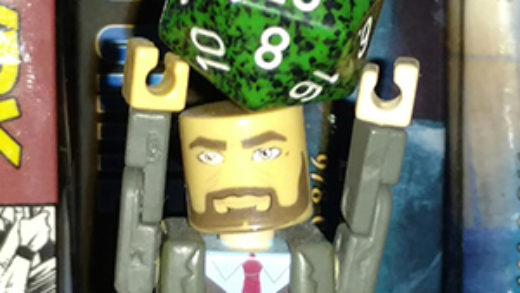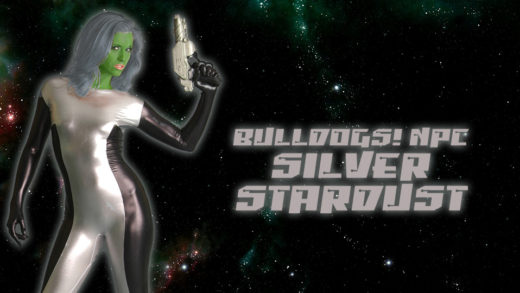As I continue with the design of my own tabletop RPG system, I’ve been thinking a lot about combat and how to streamline it for more narrative-based games and systems. This week, I offer a potential, more narrative, alternative to tactical combat.
Tactical Combat in Narrative Systems
When I use the term “tactical combat,” I don’t necessarily mean combat using a grid/hex system; I’m writing broadly of any combat in which players and the GM detail each movement and action within a fight scene. Tactical combat systems/play are a mainstay of RPGs; wether they use a map and tokens or take place in the theater of the mind. This style of combat can be time-consuming, sometimes to the point where a scene of combat can take up the greatest percentage of time in a game.
There are systems and campaigns that have a focus on combat. I’d not suggest using this alternative combat system in games like D&D, Pathfinder, Starfinder, ShadowRun, GURPS, BRP (Call of Cthulhu), due to their focus and/or simulationist nature. My approach below applies more to systems with a more narrative focus (I’m hesitant to use the term “rules light”).
When thinking about this combat approach, I had systems like Fate Core/Accelerated, PbtA, and Genesys in mind. For those systems, a narrative combat approach could help streamline or keep the session focused on the overall story. For some narrative systems tactical combat may still feature heavily, due to the nature of the players, campaign, or even based on a specific theme. Narrative combat also requires rethinking about how combat is handled, and can take some getting used to; it may be that tactical combat is used in a game for more important fights and narrative combat is used in some of the lesser brawls.
Campaign and Session Tone
I wrote briefly about tone in my Fiction and Systems post last month. Narrative combat requires an agreement and understanding between the players and GM regarding the overall tone of the campaign and the specific tone of the session. As a scene of combat will only require 1 to 3 rounds, the tone of the game establishes how potentially lethal combat may be within the narrative.
Before I continue, a note about death: One of the fundamental considerations of narrative combat is that characters only die when the player wants their character to die. This feature is not uncommon in most narrative systems, but I feel it important to call out. The tone of the session primarily determines the consequences and severity of failure for the player characters, but for narrative games, death should be within the scope of the narrative for the player.
Illustrated here are three basic tones that can be used whole-cloth or for examples and the tone set by the table. When discussing a campaign, an overall tone should be set by the group, but there may be individual sessions that depart from a campaign’s tone (especially if taking a “breather” session in a darker narrative).
Heroic/Hopeful – Only a completely one-sided “critical success” victory by the foes results in defeat; failure will usually still mean success of the PCs, but with some setbacks
Gray/”Realistic” – Individual failures can leave PCs injured and a complete loss by the PCs may result in their capture or major set-backs; PC death is atypical
Oppressive/Dark – Players may opt for more dramatic deaths or injuries of their character, a complete loss could indicate a “TPK,” characters captured with little sense of hope, or a failure of the current objective beyond the fight
Narrative Combat in Action
Narrative combat operates in two modes: secondary fight and primary fight. Secondary fights are less crucial to the overall story; often they’re referred to as fights against “mooks.” Depending on the type of game, there could be one or more secondary fights per session. Primary fights are what one might think of a “miniboss” and “boss” battles. A primary fight indicates a more important fight to the overall narrative. By this distinction, a fight against a primary antagonist could be considered a secondary fight, if a success or victory doesn’t determine a major narrative consequence. Secondary fights use a singular round of combat, while primary fights establish the overall result in three rounds of combat.
In a round of combat, the GM and players each pick the primary combat roll (usually a skill roll) for the characters. The GM first makes a single roll for all of the NPC antagonists. The success or failure of that roll may add or remove challenges/difficulties and by announcing this allows the players to contemplate the narrative and potentially re-decide their desired primary skill to roll against.
If the GM’s antagonist roll is a critical success a player may decide that their overall combat strategy is less focused on disabling the enemy as it is supporting their fellow PCs, choosing to roll against their healing or defensive skills.
Once the GM rolls and announces the outcome, the PCs now each roll their decided skill. The table then works as a group to decide what those rolls mean, narrating around the table how the characters acted and reacted within the scene of the fight.
In a secondary fight, combat is now over. A primary fight takes three rounds of narrative actions, with the third round deciding the final outcome, but still being influenced by the narrative of the prior two rounds. Systems that provided measures of success and/or failure can also provide narrative guidance for the table.
For a given round, a player’s successful roll may provide advantages in the next round of combat. A failed roll may have different outcomes depending on the system. In Fate Core, a failure would result in a Physical Consequence; Monster of the Week PCs may take Harm; Masks PCs take Consequences; Genesys PCs left with Wounds or Strains; etc.
A feature of narrative combat will typically mean the PCs, as a group, always win at the end. It would require either group decision or an overwhelming majority of failed rolls by the players to indicate a loss. Individual characters may not come away unscathed, but will always be able to continue playing their characters if they so desire.


Recent Comments